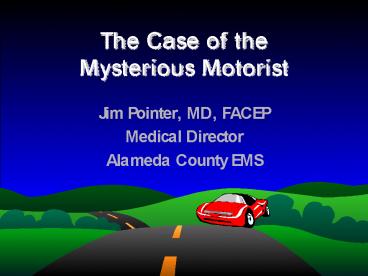The Case of the Mysterious Motorist
1 / 35
Title:
The Case of the Mysterious Motorist
Description:
... of a solo MVA. ... Carry motion, position, light touch, and vibration from the ... Light touch many tracts. Use a broken wooden q-tip on 1 or 2 sites, ... –
Number of Views:137
Avg rating:3.0/5.0
Title: The Case of the Mysterious Motorist
1
The Case of theMysterious Motorist
- Jim Pointer, MD, FACEP
- Medical Director
- Alameda County EMS
2
The Call
- You respond to the site of a solo MVA. The
unrestrained 25 year-old male drivers car struck
an embankment at 30 mph. He is ambulatory at
the scene.
3
Assessment
- ABCs no abnormalities
- Vital signs 120/100, 102, 16, 15,
- Pulse Ox - 98
- Pertinent physical findings
- Neuro no deficits noted
- Back midscapular pain that increases with
respirations
4
Field Treatment
- Full spinal immobilization
- Transport
5
Hospital Findings
- Young white male c/o back pain
- Vital signs 110/85, 80, 20, 15,
- Pulse Ox 99
6
Neuro Exam
- Upper extremities
- Strength - 1/5 hands
- 3/5 shoulders
- Sensation - slight decrease in temperature,
- pain, pinprick, and light touch
- from shoulders down
- Lower extremities
- Strength - 5/5 feet
- 5/5 upper legs
- Sensation - intact throughout
7
Central Cord Syndrome
8
Characteristics
- Most common incomplete cord lesion
- Bimodal distribution
- Spondylosis and trauma major causative agents
- Mechanism - hyperextension of the cervical cord
9
Characteristics (cont.)
- Caused by pincer effect body/osteophytes and
ligamentum flavum
10
Characteristics (cont.)
- Damage
- Central spinothalamic tracts
- Central corticospinal tracts
- Upper extremities
- greater than lower
11
Characteristics (cont.)
- Result
- Loss of motor function, much more profound
in upper extremities, particularly distally - Loss of pain and temperature sensation
upper extremities, distally
12
Spinal Cord Anatomy
13
Spinal Cord Anatomy (cont.)
- Spinal tracts
- Long fibers originating
- in the brain and
- running together
- through spinal canal
- in pairs
14
Spinal Cord Anatomy (cont.)
- Dermatomes
- Trigeminal
- Cervical
- Thoracic
- Lumbar
- Sacral
15
Spinal Cord Anatomy (cont.)
- Central Cord
- Corticospinal tracts of the anterior cord
arranged in concentric circles - Hands most central
- Arms, shoulders intermediate
- Lower extremities outer zone
16
Spinal Cord Anatomy (cont.)
- Anterior Cord
- Corticospinal tracts control of motor function
on the same side of the body
17
Spinal Cord Anatomy (cont.)
- Anterior Cord
- Spinothalamic tracts (lateral columns) carry
pain (pinprick), temperature, and light touch
from the opposite side of the body
18
(No Transcript)
19
Spinal Cord Anatomy (cont.)
- Posterior columns
- Carry motion, position, light touch, and
vibration from the same side of the body
20
Other Spinal Cord Syndromes
- Anterior Cord Syndrome
- Posterior Cord Syndrome
- Brown-Sequard Syndrome
- Complete Transection
- 11,000 spinal cord injuries
- yearly in the US.
21
Anterior Cord Syndrome
- Caused by pressure on paired anterior spinal
arteries or damage by bony fragments - Damage spinothalamic tracts
- corticospinal tracts
22
Anterior Cord Syndrome (cont.)
- Result complete loss of distal motor function,
pain, temperature sensation, light touch, motion.
Position and vibration are preserved.
23
Posterior Cord Syndrome
- Rare
- Existence doubted by some
- Damage to corticospinal tracts and posterior
columns.
24
Posterior Cord Syndrome (cont.)
- Retained spinothalamic function but lost movement
and proprioception. - Causes
- hyperextension injuries
- (falls to face/chin)
25
Brown-Sequard Syndrome
- Cause usually penetrating trauma
- Damage all tracts on one side of the cord
- Results isolated loss of all functions
- Motor same side as damage
- Motion, position, vibration same side as the
damage - Pain and temperature opposite side as the
damage
26
(No Transcript)
27
Complete Transection
- Most common serious cord injury
- Cause trauma
- Damage all tracts on both sides
- Result total loss of function on both sides
28
Treatment forSpinal Cord Injuries
29
Treatment forSpinal Cord Injuries
- Spinal immobilization
- Steroids (benefit unproven)
- Early surgery
- Traction
- Experimental protocols
- Rehabilitation
30
A Scheme for Assessmentof Spinal
Injuries(borrowed from the State of Maine
Guidelines)
- Mechanism
- Positive
- Negative
- Uncertain
31
Assessment of Spinal Injuries
- Spine Pain/Tenderness
- Pain deep neck pain
- Tenderness stairstep
- exam over spinous
- processes from top to
- bottom
32
Assessment of Spinal Injuries
- Motor exam Upper Extremity
- Finger Abduction/Adduction
- 4th and 2nd fingers together
- Tests T-1
- Finger/Hand Extension
- Push down on extensors
- Tests C-7
33
Assessment of Spinal Injuries
- Motor exam Lower Extremity
- Foot Plantar Flexion
- Press against soles of feet
- Tests S-1, S-2
- Foot/Great Toe
- Dorsiflexion
- Press against top of foot
- Test L-5
34
Assessment of Spinal Injuries
- Sensory Exam Upper Lower Extremities
- Pinprick spinothalamic tract
- Light touch many tracts
- Use a broken wooden q-tip on 1 or 2 sites, upper
lower extremities. - Ask the patient to distinguish between sharp
(the broken end of the q-tip) and dull (the
cotton end of the q-tip)
35
Assessment of Spinal Injuries
- Reliable Patient Exam
- No
- Acute stress reaction
- Brian injury
- Intoxication
- Abnormal mental status
- Distracting injury
- Communication
- Yes
- Calm Cooperative
- Sober
- Alert































